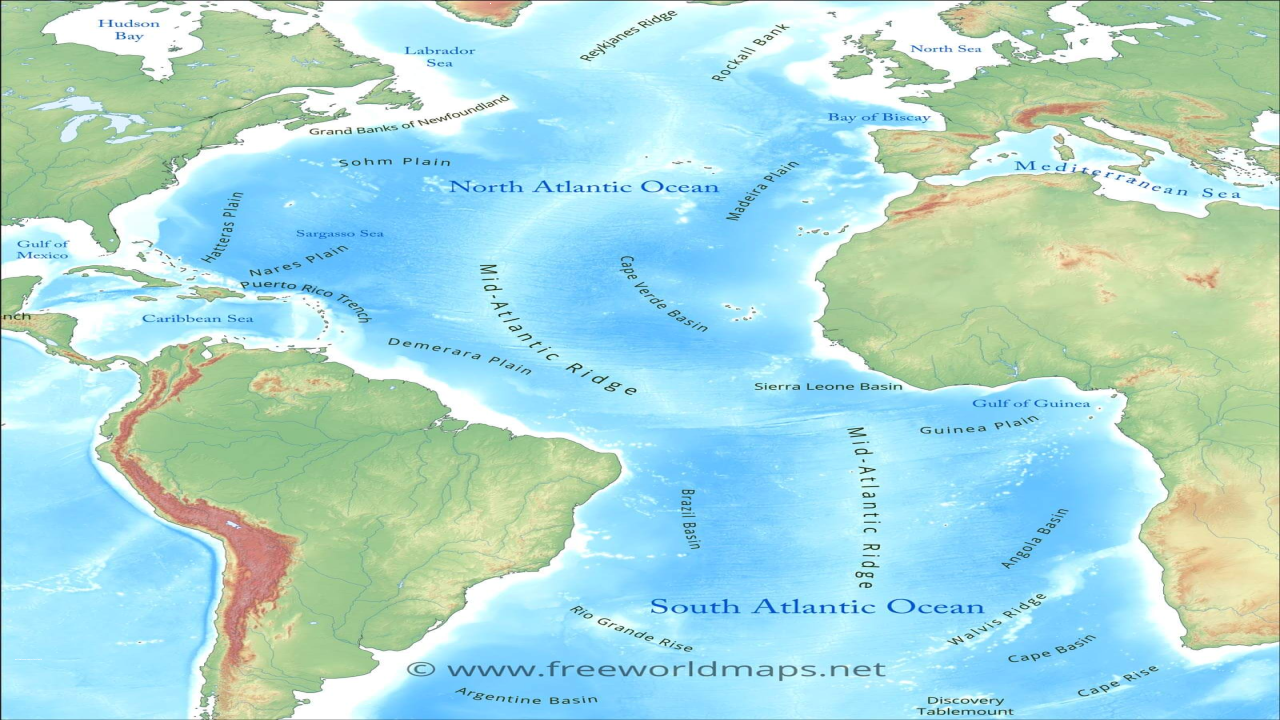Bottom topography of the Atlantic
The Atlantic Ocean is the second-largest ocean on Earth, covering an area of approximately 106.4 million square kilometers. Its vast expanse includes a diverse range of seafloor features, including mountains, ridges, and canyons, which are shaped by a range of geological and oceanographic processes.
Mid-Atlantic Ridge
The Mid-Atlantic Ridge is one of the most significant features of the Atlantic Ocean, running north-south along the center of the ocean basin. This underwater mountain range is the result of divergent tectonic plates pulling apart, leading to the upwelling of magma and the creation of new seafloor.
The Mid-Atlantic Ridge is a site of ongoing volcanic activity, with hot springs and hydrothermal vents supporting unique ecosystems of marine organisms. It is also an important site for the study of plate tectonics and the movement of the Earth’s crust.
Continental Shelves and Slopes
The continental shelves and slopes are another important feature of the bottom topography of the Atlantic Ocean. These regions are the shallowest parts of the ocean, extending from the coastlines of the continents out to the continental slope, which drops off sharply into the deep ocean basins.
The continental shelves and slopes support a wide range of marine life, including commercially important fisheries and habitats for a variety of marine mammals and other organisms. They also play an important role in the cycling of nutrients and the movement of sediments between the land and the ocean.
Seamounts and Abyssal Plains
Seamounts are underwater mountains that rise from the seafloor, but do not reach the ocean surface. They are common features of the Atlantic Ocean, particularly in the eastern and central regions. Seamounts can support unique ecosystems of marine life, including coral and sponge communities, and are important sites for fishing and other commercial activities.
Abyssal plains, on the other hand, are flat regions of the ocean floor that lie at depths of over 4,000 meters. They are some of the most extensive features of the Atlantic Ocean bottom topography and are important sites for studying the deep ocean environment and the organisms that inhabit it.
Canyons and Trenches
Canyons and trenches are other significant features of the Atlantic Ocean bottom topography. Canyons are deep underwater valleys that can extend for hundreds of kilometers, while trenches are deep, narrow depressions that are often associated with subduction zones, where tectonic plates collide and one is forced beneath the other.
The Puerto Rico Trench, located off the coast of Puerto Rico, is one of the deepest trenches in the world, with a depth of over 8,000 meters. Canyons and trenches are important sites for studying the interaction between tectonic activity, ocean currents, and marine ecosystems.
Significance of Atlantic Ocean Bottom Topography
The bottom topography of the Atlantic Ocean is significant for a range of scientific and practical reasons. It provides important insights into the geological and oceanographic processes that shape our planet, as well as supporting unique ecosystems of marine life and providing valuable resources for human use.
Understanding the bottom topography of the Atlantic Ocean is also essential for a range of practical applications, including marine navigation, fishing, and resource exploration. By studying the bottom topography of the Atlantic Ocean, we can also better understand the impacts of human activity on the ocean environment and work to mitigate these impacts.


